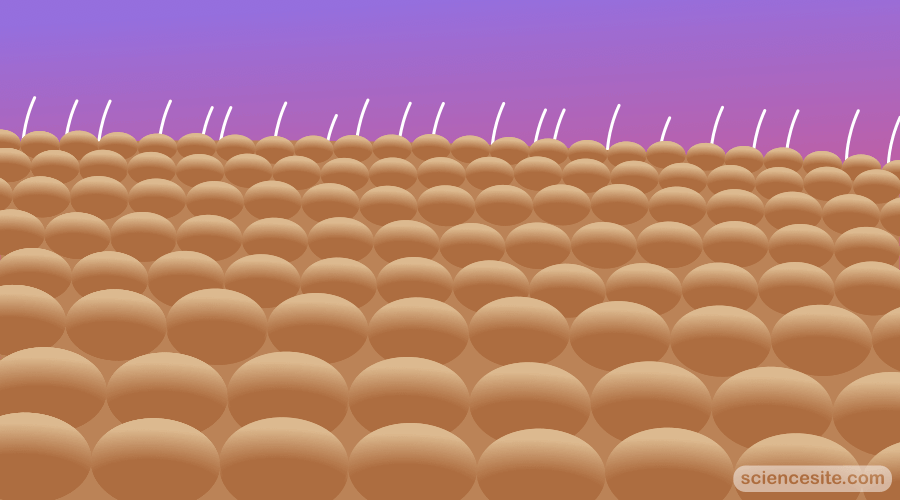Have you ever wondered why the hair on your arm or other parts of the body stands up when you’re cold or afraid? Do they have a purpose? Why do they usually develop only when we are frightened or cold?
Well, let’s delve deep into science and find out why goosebumps happen?
What are Goosebumps?
When tiny muscles in our skin flex, it causes the hair follicles to rise up a bit. This phenomenon is called goosebumps. When the hair follicles rise, they cause the hair on your body to stand up as well. These goosebumps are an involuntary reaction. The nerves that control these muscles are from the sympathetic nervous system that gives out the fight and flight response.
When it comes to animals, most animals show a similar reaction when they are threatened. The fur and hair on their neck and back stand up, giving the animals a more threatening stance. This makes the animal in the threatened position look bigger and more dangerous.
A perfectly dramatic example of this is found in porcupines. When they are threatened, the hair or should I say the spiny quills, puff out, giving itself a very dangerous stance. After sensing the danger, not only do these animals look dangerous, but they also stop their enemies in their tracks with the threatening stance.
In humans, we don’t have enough body hair to become threatening and scare off any predators or get any insulating effect. It is just an involuntary response we get when our hormones surge and cause a change in our emotions or temperature.
Purpose of Goosebumps
In cold weather, goosebumps are quite important, more so to animals than humans. They may help in conserving the heat in the body in various ways that include:
⦁ When hair follicles are raised, they cause the skin pores to close
⦁ Muscle contract when goosebumps are formed, well, similar to when heat is generated during larger muscle contraction, same happens during this.
⦁ The hairs that stand up trap a layer of air near the skin, this way they hold onto the heat.
Each of these points show that the goosebumps have more significant importance to furry animals than to humans. In fact, it’s actually unknown, as to how important as to how important goosebumps are to humans because even if we did not have goosebumps, we’ll have no problem in controlling the temperature. It might as well be something leftover from evolution that our ancestors forgot to take back, like the tailbone and coccyx that serve no function in the body.
There have been some discoveries regarding goosebumps that link the goosebumps with stem cells of the hair follicle, which might explain the longer-term response to cold. Especially, for animals that have fur, if they get goosebumps, in the short run, they conserve heat and if they get thicker fur, it can help keep them warm in the long winter months.
Goosebumps are More Than a Cold Response
We only associate goosebumps with a negative situation like when you’re feeling afraid or unnecessarily cold. But it’s more than just that. As you already know that the nerves of the goosebumps, also known as arrectores pilorum, are connected to the sympathetic nervous system.
The sympathetic nervous system gets input from many parts of the brain as it is linked to them. These parts include emotion, motivation, arousal, and some other stimuli that induce goosebumps, like:
⦁ Awe
⦁ Pride
⦁ Fear
⦁ Excitement
⦁ Seeing art or hearing music that intrigues or moves you.
Anything that compels you to say “it gives me chills,” is something that is induced by the sympathetic nervous system and you usually experience getting goosebumps.
Are Goosebumps a Sign of Disease?
Although quite rare, but goosebumps are sometimes a sign of a seizer disorder known as temporal lobe epilepsy, a sympathetic nervous system disorder. It can also be a sign of another brain disorders.
Goosebumps are also quite common during heroin or other drug withdrawals. In fact, when we say “quitting cold turkey,” it is because when you go through heroin withdrawals, the goosebumps that occur on your skin, they resemble the turkey’s flesh.
Final Words
Goosebumps are a universally occurring phenomenon but a poorly understood one. You will most likely experi ence it when you’re cold or afraid. But don’t be surprised if you experience it on other occasions as well.
Our understanding of this phenomenon is developing, and the new discoveries of the relation with hair follicles might even bring many new things to light. We might even find a cure to baldness and boost tissue healing.
Depending on the importance of goosebumps, it may be possible they will vanish in the further centuries with other evolved parts like the wisdom teeth. Or they may even be more prominent, depending on their role.


